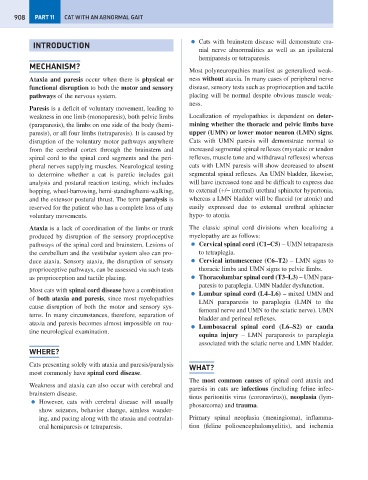Page 916 - Problem-Based Feline Medicine
P. 916
908 PART 11 CAT WITH AN ABNORMAL GAIT
● Cats with brainstem disease will demonstrate cra-
INTRODUCTION
nial nerve abnormalities as well as an ipsilateral
hemiparesis or tetraparesis.
MECHANISM?
Most polyneuropathies manifest as generalized weak-
Ataxia and paresis occur when there is physical or ness without ataxia. In many cases of peripheral nerve
functional disruption to both the motor and sensory disease, sensory tests such as proprioception and tactile
pathways of the nervous system. placing will be normal despite obvious muscle weak-
ness.
Paresis is a deficit of voluntary movement, leading to
weakness in one limb (monoparesis), both pelvic limbs Localization of myelopathies is dependent on deter-
(paraparesis), the limbs on one side of the body (hemi- mining whether the thoracic and pelvic limbs have
paresis), or all four limbs (tetraparesis). It is caused by upper (UMN) or lower motor neuron (LMN) signs.
disruption of the voluntary motor pathways anywhere Cats with UMN paresis will demonstrate normal to
from the cerebral cortex through the brainstem and increased segmental spinal reflexes (myotatic or tendon
spinal cord to the spinal cord segments and the peri- reflexes, muscle tone and withdrawal reflexes) whereas
pheral nerves supplying muscles. Neurological testing cats with LMN paresis will show decreased to absent
to determine whether a cat is paretic includes gait segmental spinal reflexes. An UMN bladder, likewise,
analysis and postural reaction testing, which includes will have increased tone and be difficult to express due
hopping, wheel-barrowing, hemi-standing/hemi-walking, to external (+/− internal) urethral sphincter hypertonia,
and the extensor postural thrust. The term paralysis is whereas a LMN bladder will be flaccid (or atonic) and
reserved for the patient who has a complete loss of any easily expressed due to external urethral sphincter
voluntary movements. hypo- to atonia.
Ataxia is a lack of coordination of the limbs or trunk The classic spinal cord divisions when localizing a
produced by disruption of the sensory proprioceptive myelopathy are as follows:
pathways of the spinal cord and brainstem. Lesions of ● Cervical spinal cord (C1–C5) – UMN tetraparesis
the cerebellum and the vestibular system also can pro- to tetraplegia.
duce ataxia. Sensory ataxia, the disruption of sensory ● Cervical intumescence (C6–T2) – LMN signs to
proprioceptive pathways, can be assessed via such tests thoracic limbs and UMN signs to pelvic limbs.
as proprioception and tactile placing. ● Thoracolumbar spinal cord (T3–L3) – UMN para-
paresis to paraplegia. UMN bladder dysfunction.
Most cats with spinal cord disease have a combination
● Lumbar spinal cord (L4–L6) – mixed UMN and
of both ataxia and paresis, since most myelopathies
LMN paraparesis to paraplegia (LMN to the
cause disruption of both the motor and sensory sys-
femoral nerve and UMN to the sciatic nerve). UMN
tems. In many circumstances, therefore, separation of
bladder and perineal reflexes.
ataxia and paresis becomes almost impossible on rou-
● Lumbosacral spinal cord (L6–S2) or cauda
tine neurological examination.
equina injury – LMN paraparesis to paraplegia
associated with the sciatic nerve and LMN bladder.
WHERE?
Cats presenting solely with ataxia and paresis/paralysis
WHAT?
most commonly have spinal cord disease.
The most common causes of spinal cord ataxia and
Weakness and ataxia can also occur with cerebral and
paresis in cats are infectious (including feline infec-
brainstem disease.
tious peritonitis virus (coronavirus)), neoplasia (lym-
● However, cats with cerebral disease will usually
phosarcoma) and trauma.
show seizures, behavior change, aimless wander-
ing, and pacing along with the ataxia and contralat- Primary spinal neoplasia (meningioma), inflamma-
eral hemiparesis or tetraparesis. tion (feline polioencephalomyelitis), and ischemia

